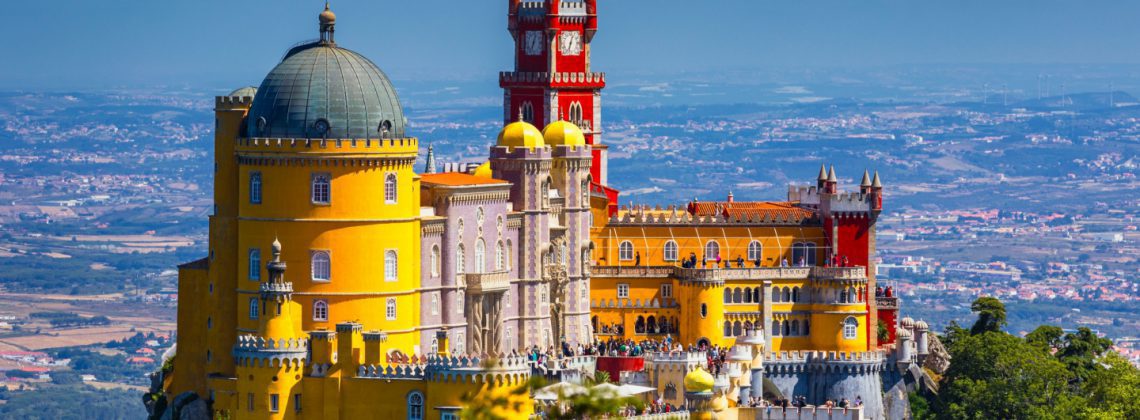Portugal has been one of the most in-vogue destinations over the last few years. Sintra is a big part of that success, with a history that spans millennia, a rich gastronomical culture, beautiful natural environments, and everything in between. It can be hard to figure out where and how to spend your time. Well, don’t worry. The Tour Guy is here to break it down! With a host of recommendations on accommodation, activities, tours, and restaurants, all given by our local travel experts, all you’ll need to do is click book now, sit back, and daydream of Portugal.
Pro Tip: Planning a trip to Portugal? Organizing your trip is easier when you have all your resources in one place. Bookmark this post along with our Portugal guide for more planning resources. Also, check out our Best Places to Stay in Sintra, Best Places to Stay in Lisbon, and Where to Stay in Cascais for the lowdown on great accommodation.
The Best Things To Do and See Around Sintra
Sintra has enchanted visitors for millennia. Ptolemy referred to it as ‘The Mountains of the Moon,’ associating it with the stars and the cosmos. 19th Century Portuguese author José Maria de Eça de Queiroz purred, ‘Everything in Sintra is divine. No corner is not a poem.’ While English romantic poet, Lord Byron, declared it a ‘Glorious Eden.’
Located just forty minutes North-West of Lisbon, Sintra’s microclimate makes it the perfect place to escape when the city gets too hot. The ancient town lies in a valley—just one mile from the pounding Atlantic Ocean. Romantic palaces sit perched on hilltops, forests sit covered in a mist that sometimes seems never to lift, and in the distance, waves smash against the most westerly tip of Europe.
No surprise then that Romans, Arabs, kings and queens, farmers, and poets have all called this magical place home at some point. For the tourist, there can be so much to see it can overwhelm, thankfully, I’ve been leading tours of Sintra for the past eight years, so let me guide you through my list of the top things to do in Sintra.
1. Step Into a Fairytale at Pena Palace
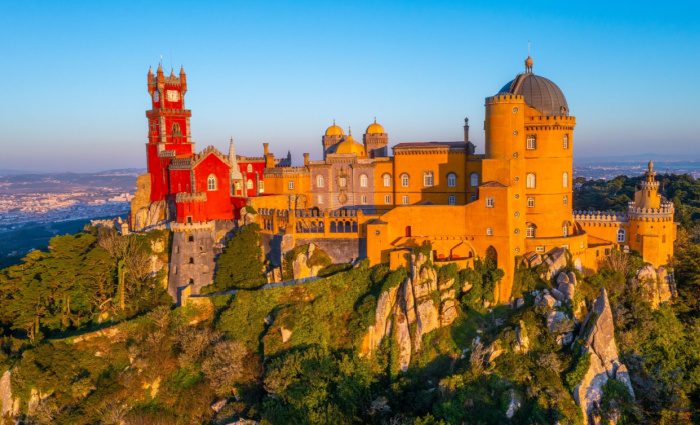
Nestled amongst the high peaks of Sintra, the Pena Palace is one of the most visited attractions in Portugal. And for a good reason.
According to legend King Manuel I was hunting in these mountains in 1503 when he spotted the returning ships of Vasco da Gama’s second voyage to India. Thankful for their safe return, he built the Royal Monastery of Our Lady of Penha over an already-existing chapel.
It was badly damaged by the earthquake of 1755 and then abandoned in 1834 after the abolition of religious orders in Portugal. The restored monastery is today the central core of the Royal Palace of Pena, built by King Ferdinand II in the mid-1800s
The rugged terrain of the area (Penha in Portuguese means crag) made the palace challenging to construct. So instead of architects, the King hired a mining specialist, Baron Von Eschwege, to bring his vision to life.
Its bright colors and eclectic architectural style define it as one of the grand Romantic palaces of Europe—the jewel of Sintra and a love letter written by King Ferdinand II to the history of Portugal.
Insider Tips:
As of 2023, tickets for the palace are timed. They are very strict with timings. Because of this, we suggest starting your day at Pena. That way, fewer things can go wrong, and your arrival will be on time. The palace entrance is a 30-minute uphill walk from the entrance to the park. Build this into your arrival time.
Location: Pena Palace
2. Get Back to Nature at Pena National Park
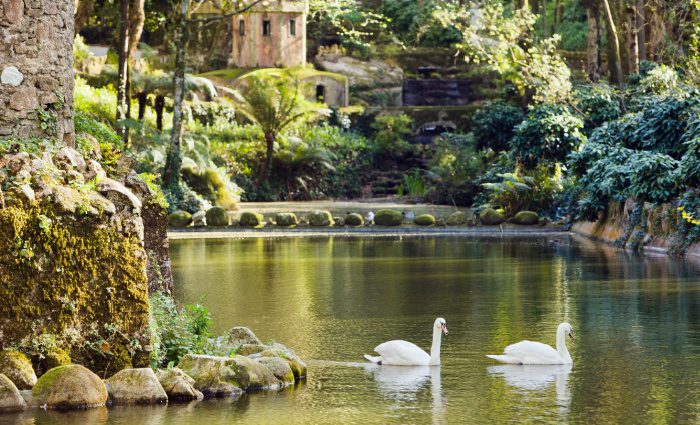
When King Ferdinand II bought the abandoned Monastery of Our Lady of Pena in 1838, the surrounding land was craggy, arid, and rocky. Few could have imagined the luscious transformation over the last 150 years.
Today the park of Pena is a majestic expression of the Romantic model of parks. Often seen as a reaction to the Industrial Revolution, the Romantic movement was a rejection of the pragmatic and ugly aspects of industrialization, and instead, it embraced the natural and fantastical.
The park began to be arranged in 1839 and progressed under the watchful eyes of King Ferdinand II. Gone were the neat and orderly gardens of the royal palaces of France and England and an expression of naturalism put in their place.
Grottos and follies abound. They are engulfed by forests that seem plucked from another land. Indeed, in many cases, they are. The King’s gardeners brought species from England, France, Brazil, America, Africa, and Australia. In the Queen’s Fern Valley, you’ll find a beautiful American Western Red Cedar standing sentinel over leafy arboreal ferns sourced from New Zealand and Australia. Then head to the Camellia Garden to see species brought over from China and Japan that have become symbols of winter in Sintra.
Today you can stroll through the Valley of the Lakes. Then, climb to the High Cross before descending into the Queen’s Fern Valley. The Pena palace is always crowded. But, the gardens are an oasis of calmness. Perfect for kids to explore and get lost in Sintra’s magic.
Insider Tips:
My favorite season in the park is winter. When the fog sits low, and the paths are dark. There is something profoundly mysterious and yet safe about the winding paths. Perfect for an invigorating hike. One of the joys of Sintra is how dramatically it changes through the seasons.
3. Unravel the Secrets of Quinta Da Regaleira

The eccentric businessman António Augusto Carvalho Monteiro had Quinta da Regaleira built between 1902 and 1910. The density of symbols speaks to Monteiro’s love of secret societies, ancient Egypt, Eastern religions, and more. In the past, the palace has been described as a; Masonic temple, the Castle of the Holy Grail, and Dan Brown’s wet dream!
The design of Monteiro’s palace and the surrounding gardens was so fantastical that rather than hire architects, he hired the Operatic set designer Luigi Manini to bring his fantasies to life. The results of Manini’s work at Quinta da Regaleira are a splendid country house filled with masonic symbology and references to the Knights Templars.
Filled with caves and caverns, the garden and its dark nooks—create an almost Limbo-like space between light and dark. Heaven and Hell.
The centerpiece of any visit is the initiation well. A dry well that we enter from the top. We descend nine flights of stairs, an allusion to the nine circles of Dante’s Inferno. At the base, an eight-pointed star directs us into the mountain’s bowels. Darkness envelopes us until we are reborn into the light. Are we initiated into some mysterious sect? Unlikely, but it makes a great story.
Location: Quinta da Regaleira
4. Follow in the Footsteps of Royalty at the Palácio Nacional
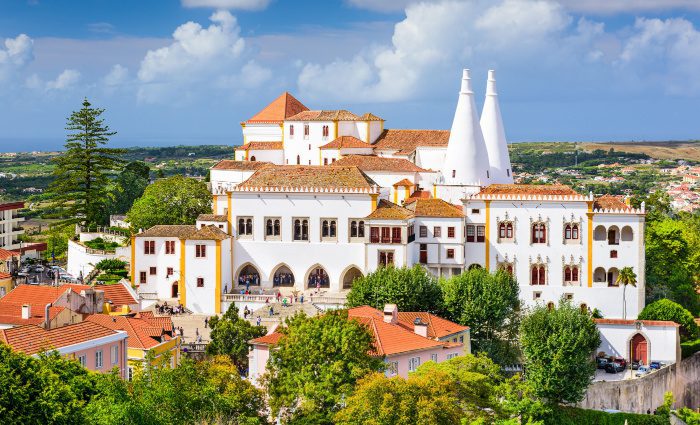
Pena Palace has curb appeal. Quinta da Regaleira a quirkiness. But the gem of Sintra seems to be hidden in plain sight. Crowds are never large at Palácio Nacional de Sintra, but the history is vast.
First mentioned during the Islamic occupation of the lands by geographer Al-Bacr. He mentions two castles in the region, one on high ground (probably the Moorish castle) and one in the town, most likely the National Palace. The Moorish legacy lives on, as the palace is home to the world’s largest collection of in-situ Mudjar tiles (Hispano-Moorish tiles, often fired in Sevilla).
It is the only palace in Portugal whose history is at least as long as that of Portugal itself. Here you will stroll through the grand reception Hall of the Swans. Hear tales of marital outrage in the Room of the Magpies and of attempted regicide in the Heraldic Hall, all before whetting your appetite with tales of great feasts in the royal kitchens.
Location: National Palace of Sintra
5. Soak up the Views at the Moorish Castle
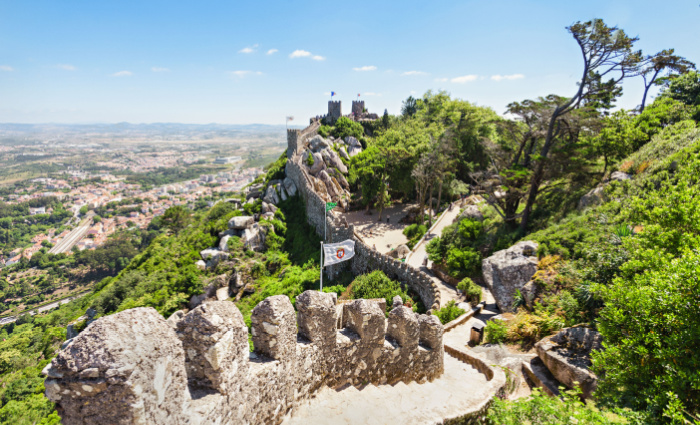
The Moorish castle is likely the first thing you’ll see as you step off the train at Sintra. It twists and turns, drops and rises, and perches menacingly as it molds itself to the steep cliffs.
The views from here are unparalleled. To the West, you will have vast sweeping Atlantic Ocean vistas. To the South are majestic views of the Pena Palace, and the Northern terraces look straight down into the historic town of Sintra and the National Palace. All while being surrounded by 360 degrees of verdant countryside.
The Moorish castle was first built in the 7th or 8th Century during the Islamic occupation of Sintra. Today its ruins extend 450m, largely rebuilt in the 19th Century by King Ferdinand II. But still, it evokes feelings of a different time.
The ruinous state and steep steps mean this site is less accessible than the others. Therefore, I suggest waiting until children are at least six and older before exploring these ruins, and those with mobility issues should look to the other more accessible sites of Sintra.
Location: Moorish Castle
6. Go West at Cabo da Roca
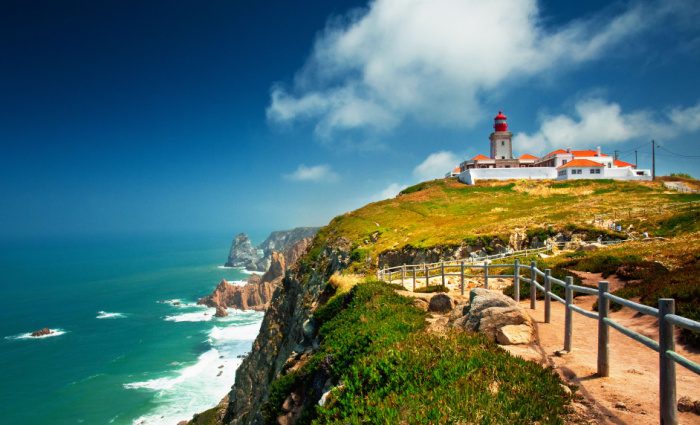
The lighthouse is closed to the public, and the small cafe is OK at best. But who cares? This is the end of the world!
Cabo da Roca marks the most westerly tip of Europe. For the ancients, this was the end of the world. After this, just infinite nothingness.
Today it’s an excellent place to make yourself feel small. Take it all in. Its vastness, its ruggedness, and remember, this too shall pass.
Grab a glass of wine and watch the sun disappear into the deep blue Atlantic Ocean.
Location: Cabo da Roca
7. Take a Plunge at Praia Grande
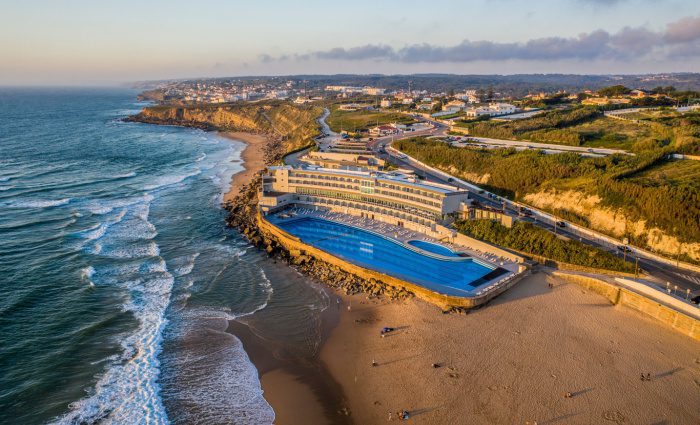
The hills of Sintra slope Westerly into the Atlantic Ocean. There are several beautiful beaches along this stretch. For general accessibility and amenities, we suggest Praia Grande—Sintra’s largest beach. Unfortunately, the waves here rock in at some speed, which is unsuitable for swimming. But if you have ever wanted to learn to surf, a few surf schools here offer private and group lessons.
If you want to take a dip, why not book a room at the Arribas Sintra Hotel? This modern 4-star hotel is popular in the summer due to its stunning views and 100m seawater swimming pool (one of Europe’s largest). Amazingly, it’s so close to the ocean that on rough days, the waves of the Atlantic crash into the pool itself.
Oh! Did we also mention there are dinosaur footprints on the cliffs facing the beach? I mean, how cool is that?
Insider Tip:
If you don’t want to spend the night at the Arribas Hotel Sintra, you can still purchase access to the pool. Day passes cost €11.50 on weekdays and €13.50 on weekends.
Location: Praia Grande
8. Drink Rare Wines at Adega de Colares

In the late 19th century, a plague of Phylloxera hit Europe. These little green vine-eating bugs destroyed almost 75% of European vineyards. However, in Lisbon, one wine region seemed immune. That was Colares.
Colares is the most Westerly DOC Wine region in Europe and its smallest. Unlike any other wine I know of, Colares wine grows on sand dunes, dug deep into the ground to reach the clay (upto 3 to 4 meters deep). The Vines sprawl along the ground rather than the traditional organized rows.
At its peak, 2500 acres of land produced Colares wine. Today there are just forty-five. The constant battering of sea winds and the heavy sea fog that covers the vineyards imbue this wine with a mineral and salty aftertaste, like drinking a wine made especially for Posedin.
Today you can visit the Adega de Colares and learn about the storied production. Tastings and vineyard tours are available, and the shop inside is one of the few places in Lisbon you can buy one of the 3500 bottles they produce each year. Such small production numbers make this one of the rarest wines in the world today.
Location: Adega de Colares
9. Take a Romantic Stroll Around The Palace of Monserrate
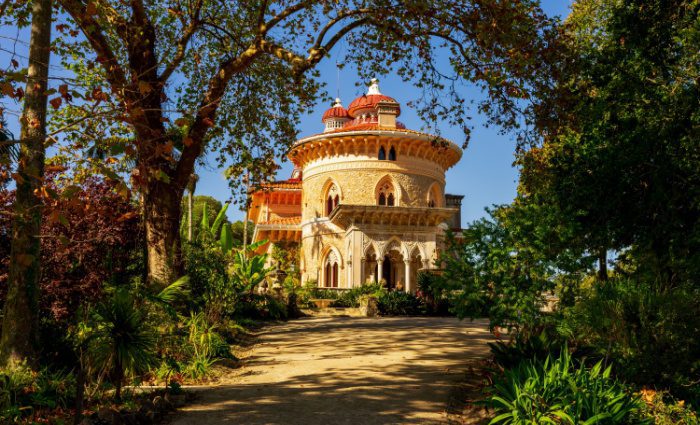
A popular spot amongst the Brits for the last two centuries, the Monserrate Palace has been a magnet for poets and artists since the 1700s. The property was bought in a dilapidated state in 1856 by Francis Cook, who entrusted the work to the British architect James T. Knowles Senior in 1858.
The building is constructed in an Oriental revivalist style, half Indian and half Moorish, with mosque-like elements. A highlight of the Romantic Era of palace building within Sintra, and Europe as a whole, the gardens help elevate it to an even higher level. Laid out by landscape designer William Stockdale and master gardener Jame Burt the romantic gardens twist and wind through a variety of indigenous species.
Cork oaks and aboral ferns mix with Mexican white camellias, azaleas, and rhododendrons, while bamboo gardens recreate a sense of the Japanese gardens becoming popular at the time. Through ruins, shady alcoves, and beautiful lakes and you have yet another wonderful spot to spend an afternoon.
Location: Palace of Monserrate
10. Be Adventerous at Praia da Ursa
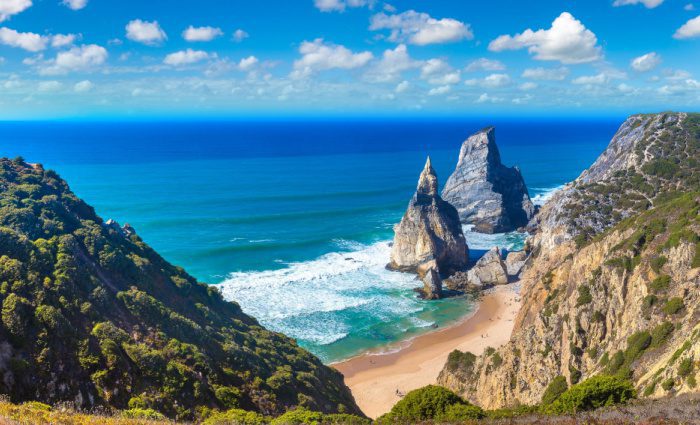
According to local legend, during the last ice age, a bear lived in the caves of this area. As the ice thawed, God ordered all the animals to leave, but the bear refused. As punishment, the bear and her cubs were turned to stone. Today they stand as stone sentinels that watch over the coast.
One of Portugal’s most beautiful beaches, as well as Europe’s most Westerly, Praia da Ursa though beautiful, is not a beach for those with children or mobility issues. The only way down to the beach is down via a treacherous dirt path. When on the beach, there are no facilities and no lifeguards. The nature of the Atlantic Ocean means the ocean barrels in at high speed, this is a beach for enjoying the majesty of nature rather than enjoying a refreshing swim.
A truly beautiful spot, but one to definitely treat with caution and respect.
Location: Praia da Ursa
11. Explore the Ruins of the Capuchin Convent
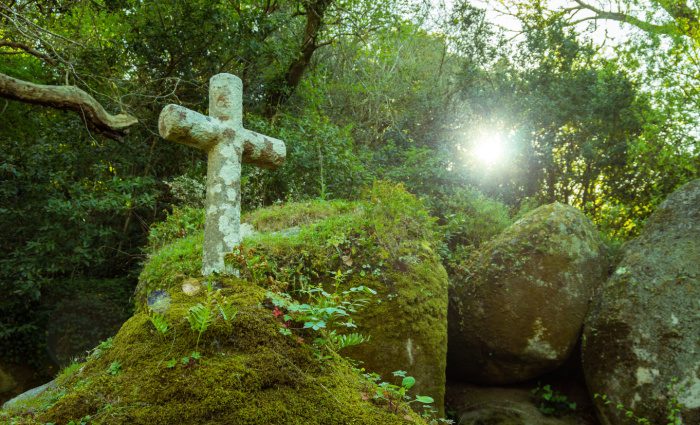
Founded in 1560 by the Capuchin Friars of the Arrábida, the land surrounding the abandoned Capuchin convent is a rambling and meandering sprawl of forest and abandoned buildings. You’ll still find the Chapter Hall, the Apothecary, and the simple cells that the monks would have retreated to.
Being a little more off the beaten track, you can spend a very quiet afternoon here, especially in the low season.
Location: Convent of the Capuchos
12. Drink in the Sunshine at Azenhas do Mar
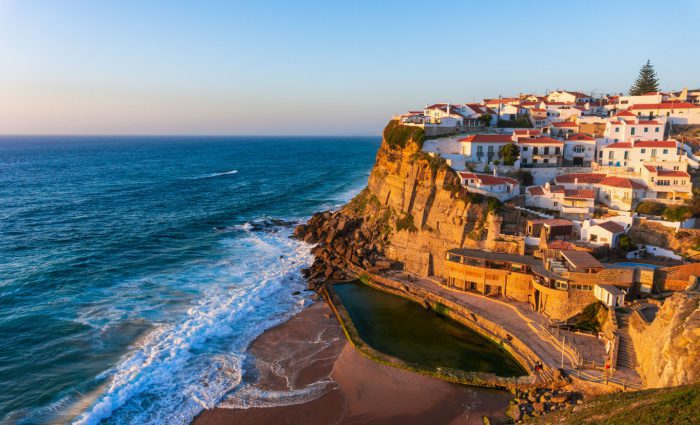
A picture-perfect postcard town, Azenhos do Mar has been a popular bathing destination since the 1930s. The beautiful white seaside cottages cascade down to the small beach below, a man-made sea pool is filled at high tide and remains filled most of the day, offering wonderful bathing opportunities.
Although a popular summer destination with locals, I love winter here. From November, the Ocean whips up a thunderous noise as it smashes against the golden cliffs. With numerous small restaurants, this is the perfect place to end a trip to Sintra with a glass in hand and a plate full of the sea’s bounty.
Location: Azenhas do Mar
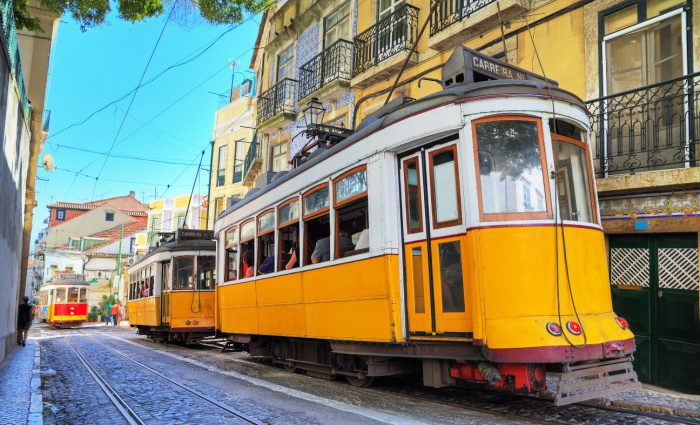
Where To Stay in Lisbon
One of Europe’s hottest destinations. Find our guide to the best places to stay in Lisbon!
